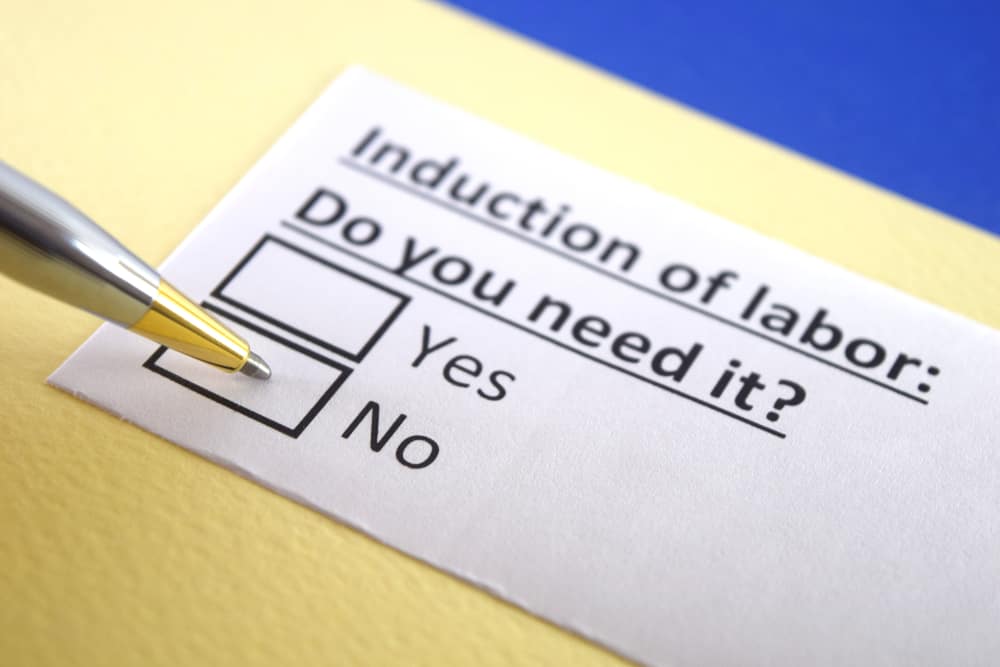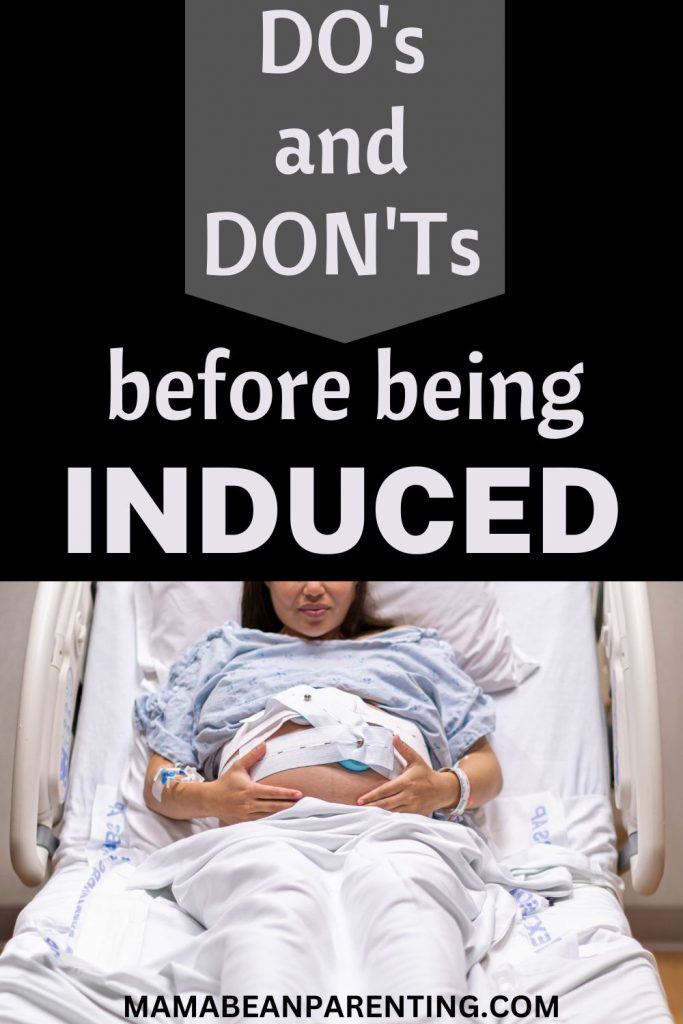Do’s and don’ts before being induced are important to know for every pregnant woman.
Some pregnant women know they will be induced, and in that case, it is crucial to learn all the information about labor induction.
On the other hand, some women don’t expect to be induced so they’re not very interested in this topic.
I believe it’s important for every woman to learn more about labor induction, do’s and don’ts before being induced, and all the other relevant information.
You never know what could happen. Childbirth can be surprising, and it’s good to inform yourself about every possible income.
When you know something, your mind is more peaceful, which is also essential for a successful delivery.
This article will certainly enrich your knowledge about this topic. You will be surprised by some facts and you will be more confident and brave when it comes to childbirth.
What Is Labor Induction?

Maybe you’ve heard of this term, or your doctor mentioned it. You expect a labor induction, but you’re not sure what it is.
Labor induction is a medical treatment that stimulates uterine contractions to start childbirth.
There are a few different types of labor induction and there are different reasons for doing it.
Many women think it’s an aggressive treatment, but sometimes this is the only way for safe delivery.
Reasons For Labor Induction
Many pregnant women believe that they will be induced only if something bad happens. However, the reality is different.
Sometimes everything seems great, and you feel good, but the doctors want to start induction.
Because of this, I want you to learn more about the reasons for labor induction.
Post-term Pregnancy
If you’re pregnant for more than 42 weeks, and your contractions are still not happening, your doctor will suggest labor induction.
Many moms believe their baby will come out when it’s ready and that their bodies will start having contractions when it’s time, but this is not always true.
There are many risks for you and the baby if you’re pregnant for more than 42 weeks.
The placenta, which is essential for keeping the baby alive and transferring food and oxygen, will slowly stop working after 42 weeks of pregnancy.
Additionally, if you don’t get induced, there are many possible health risks involved. There is also a higher chance of C-sections in post-term pregnancies.
C-section sounds easier, but it’s major surgery with more risks than natural, vaginal childbirth.
Fetal Growth Restriction
Fetal growth restriction or intrauterine growth restriction is a condition where a baby’s growth is compromised.
It simply means the baby is too small for some reason. The doctor determines this by doing a prenatal ultrasound.
This is also a reason for being induced because, in some cases of fetal growth restriction, the baby’s life is compromised.
Pre-eclampsia
Pre-eclampsia is a disorder connected to a mother’s health. It’s characterized by high blood pressure and high protein levels in urine during pregnancy.
It usually appears after the 20th week of pregnancy.
This condition can only be connected with high blood pressure, but it often causes other health complications – liver issues, kidney failure, bleeding, swelling, respiratory issues, visual problems…
Pre-eclampsia is a dangerous condition for both mother and baby. If the seizures, also known as convulsions, start to happen, then it’s a case of eclampsia.
Both pre-eclampsia and eclampsia are life-threatening conditions. Since doctors want to avoid additional risks, they often do a labor induction to get the baby out as soon as possible.
Pre-eclampsia usually goes away after the delivery. The reasons for this condition are obesity, pre-pregnancy high blood pressure, diabetes, and older age.
However, in many cases, there is no specific reason for pre-eclampsia.
Some women had it in all of their pregnancies, and some even had miscarriages because of this condition. Luckily, there are ways to manage this condition, but there aren’t ways to prevent it.
Diabetes
High blood sugar can often be dangerous for pregnant women and their babies in the womb. Sometimes it can be managed, and if the doctor determines that the baby is ready to be born, labor induction will happen.
Gestational diabetes is quite common, and it happens when the glucose levels in the blood are too high. This condition usually goes away after childbirth.
Some women had diabetes before they became pregnant, and labor induction is recommended for them too.
Chorioamnionitis
Chorioamnionitis or intraamniotic infection is often called an infection of the uterus. As a matter of fact, it’s an infection of the chorion and membranes of the placenta.
Placenta is an organ present in a woman’s body only when she’s pregnant. It transfers nutrients, oxygen, food, and other vital things essential to a baby’s life.
Chorioamnionitis or intraamniotic infection can be treated with medications if it’s still early to give birth. This condition can cause premature labor.
If it’s not too early, the woman with this condition will be induced. Microorganisms cause this condition, and it can cause other complications.
Premature Rupture Of The Membranes – PROM
Premature rupture of the membranes is also known as PROM. This is a condition where all the membranes have ruptured, but there are no signs of contraction, and the labor is not starting.
Since it would be risky to wait for too long, women with this condition are being induced to avoid possible complications.
Previous History Of Stillbirths
Unfortunately, some women have bad luck when it comes to pregnancies. Something that should be the happiest time of their life becomes a nightmare.
However, that is not a reason to give up on the idea of being a mother. Many women have fought and won.
If this is the case, you should expect labor induction because the doctors will want to get that baby out of you as soon as possible to avoid negative outcomes again.
As you can see, being induced truly saves lives, and there is no reason to have a negative attitude toward it.
Twin Pregnancy
Many pregnant women with twins have a C-section since it can be hard to deliver two babies, especially if they’re pregnant for the first time.
As always, doctors will try to deliver the babies naturally.
Since there is a higher risk for certain conditions when there are two or more babies in the womb, being induced is a recommendation in many cases.
This is usually done if your labor is not starting after the 38th week of pregnancy.
Many women deliver one child naturally and the other child by C-section.
Giving birth to more than one baby can be very complicated, so being induced is just one of the many possible treatments.
Obesity And High BMI
It’s hard for obese women with high BMI – body mass index to get pregnant, and those pregnancies are usually more complicated and well-monitored by the doctors.
Obese women usually have certain health conditions that can be dangerous for them and their babies.
It often happens that their delivery starts earlier, but if it doesn’t, the doctor will suggest labor induction. Being induced will prevent possible complications.
Other Health Conditions
I’ve mentioned the most common reasons for being induced.
However, there are so many illnesses, health conditions, and complications that can be the reason for induction (oligohydramnios – low or leaking amniotic fluid, placental obstruction or abruption, etc.)
Many women live with certain health conditions their whole lives, but they still want to have babies and become moms. They risk everything to do that.
Therefore many measures are taken to achieve this. Labor induction is one of the simple ones.
Being induced also happens because of the baby’s health conditions. These days, many things can be seen by ultrasounds and determined by doing different tests.
If a doctor thinks your baby is in danger and it’s better to start the delivery fast, induction is one of the methods to do this.
Elective Induction
Elective induction means there is no medical reason to do it. Sometimes it’s more convenient, and if the mother and the doctor agree on this, induction is done.
Types Of Induction

Now that you know so many reasons for being induced, it’s time to learn more about different types of induction.
There are four main types, and each of them is different than the other. Depending on your situation, the doctor will determine the best induction type for you.
Prostaglandin Induction
Prostaglandin induction is a common method of induction. Prostaglandins are substances similar to hormones, and they can affect the cervix and uterine contractions.
Prostaglandin induction can be done by putting a gel into a woman’s vagina to soften the cervix and prepare it for labor and to induce uterine contractions.
Preparing the cervix for labor is also called “priming”. It doesn’t have to be a prostaglandin gel, it can also be a prostaglandin tablet.
Sometimes, the doctor will give a prostaglandin IV to induce labor. All these methods are done in a hospital under supervision.
When you start with induction, you stay in the hospital from then on.
Some women had negative reactions to prostaglandin. Those reactions include vaginal swelling and soreness, nausea, vomiting, and similar symptoms.
Sometimes, a prostaglandin induction can cause too many uterine contractions. In this case, you will receive medicine to relax the uterus.
Prostaglandin induction is standard, but most women need further assistance to give birth.
Induction With Balloon Catheter
Induction with a balloon catheter is a simple type of induction. It’s also called Foley-bulb induction.
A catheter – tube with a deflated balloon is inserted into your vagina.
When the doctor inserts it, he inflates the balloon with water. This balloon is putting pressure on your cervix, preparing it for labor.
This balloon catheter should be in there for about 12 hours. The woman is in the hospital and monitored by doctors and nurses.
After the removal, a vaginal inspection determines the next step. Most women find this method quite painless and comfortable.
Oxytocin Induction
Oxytocin induction is also a frequent method of being induced. Oxytocin, also called Pitocin, is a hormone that your body naturally produces to get you into labor.
When that doesn’t happen, a doctor will give you this hormone through IV. The nurse will place a needle in your vein, usually on your arm.
There is a small pump that is responsible for measuring the exact amount of oxytocin you’re receiving. The nurse will turn up the drip every half an hour until you start going into labor.
Oxytocin induction is efficient, but some women spend much time on the drip. It all depends. Some women go into labor after a few hours, and some wait for a day.
Oxytocin induction differs slightly from other methods because you will be attached to IV and other machines. It’s necessary to track the baby’s heart rate and yours too.
If the uterus starts contracting too much, the nurse will slow down the drip or adjust it.
Artificial Ruptures Of Membranes
Artificial rupture of membranes, also called ARM, is usually a synonym for breaking water by doctors. It’s also called breaking the amniotic sac.
It can also mean removing the membranes manually. The doctor will try to strip the membranes by using their hands.
Doctors usually decide to break the water if the cervix is ready for labor, but nothing else is happening.
This procedure is not painful, but many women describe it as uncomfortable. This breakage has to be done, but it usually doesn’t cause uterine contractions.
Most doctors combine breaking the water with oxytocin induction. There are possible risks when the water is artificially broken, but doctors and nurses are trained to deal with any complications and issues.
Risks Of Induction

Everything in life has certain risks. Even if you could give birth without help, something negative could happen.
Labor induction has its risks, but if you find a trustworthy doctor, don’t worry. Some women had negative experiences with being induced because the doctors were not patient enough.
Labor and contraction take time. Sometimes it’s not necessary to be induced. This is the main reason you need a doctor who will take care of you and your baby.
Complications
Complications can happen during natural birth, but they can also be a consequence of induction.
Medications given to you to cause contractions can also cause fetal distress, uterine rupture, jaundice, bleeding, or longer labor.
Induction can also cause uterine atony. Uterine atony is a condition where uterine muscles are not capable to contract at all.
This condition can be treated with fundal massage or medications.
There is also a risk of infection. If you were induced by the artificial rupture of membranes, it’s possible to get an infection.
More Interventions
Induction is sometimes necessary. However, the baby doesn’t know it, and it stays in the uterus, not changing its position.
Since the baby is not moving quickly through the birth canal, the doctors often have to use the vacuum technique or other methods to pull the baby out.
There is also a higher chance of epidural and C-section if a woman is induced. As I’ve mentioned, the labor usually lasts longer when it doesn’t start naturally.
This causes women to lose their strength to push, and they’re in pain for too long. For that reason, an epidural is often needed for pain management.
Sometimes everything lasts for too long, and the risks are higher and higher, so doctors decide to perform a C-section.
Higher Risk For Intensive Care
Labor induction is sometimes done to save the baby’s life. Sometimes the chances for a healthy baby are better when the baby is outside the womb.
However, this means that the baby could be a preemie or that it could have certain health complications.
Because of this, it’s necessary for a baby to receive intensive care right after birth. The doctors will determine for how long the baby will receive intensive care.
Failed Induction
Failed induction happens more than your think. This is complicated since the medications can cause complications, and the labor is not starting.
If this is the case, doctors usually decide to deliver the baby through a C-section.
Postpartum Depression
Pregnant women who have to go through induction, usually have harder and longer delivery. Some complications can happen, and all of that can be difficult to process.
I’ve mentioned in many of my articles that postpartum depression is common. It’s something that happens more than we think, but people are still silent about it.
This is a difficult mental condition that is treatable, but only if a woman asks for help.
Many women refuse to admit it, and many women think that their poor mental state is a consequence of hormones and emotional sensitivity.
Postpartum depression is real and it can seriously affect lives. Labor induction is something that can cause this.
All the fear, preparation, pain, and process are something that can’t be forgotten. Many women are traumatized by it, and they don’t even realize it.
Do’s And Don’ts Before Being Induced

You came here to learn more about do’s and don’ts before being induced, but this article gave you everything you need to know about induction.
Many women aren’t educated enough and it’s important to know more about this and similar treatments.
As I’ve said, this is a great method that can save lives, but it’s also risky and sometimes unnecessary. When you’re aware of this, it’s easier to make the right decisions.
So, let’s start with do’s and don’ts before being induced.
The first thing to do is ask questions and educate yourself. If you’re scared and anxious, don’t be afraid to ask everything, even if you know it.
It’s okay to be scared and confused. Another important thing on the list of do’s and don’ts before being induced is good preparation.
Prepare your hospital bag because if you’re scheduled for an induction, you will stay there for a while. Pack everything you need.
Even if you’re not getting induction for labor, you still need to pack the essentials. One of the things to prepare and pack for the hospital is your birth plan if you have one.
A well-packed hospital bag will help you so much through all of this.
It’s also recommended to eat before being induced. You can eat before being induced, but you can’t eat while you’re being induced.
I also suggest putting going to the bathroom on your list of do’s and don’ts before being induced. This should be done even without induction.
Most women who don’t empty their bowels will poop during vaginal delivery. All the pushing and the pressure do that.
Don’t worry, every healthcare provider sees this all the time. I just want you to know that it is possible.
Since induction for labor usually takes a while, consider taking your partner with you. Just make sure to check with your healthcare provider if is it allowed to do that.
Some hospitals have strict policies, and it’s always good to know if something is okay or not.
When it comes to things you shouldn’t do before being induced, the first thing is avoiding fat, sweet, and hard-to-digest foods.
There is a chance you’ll get nauseous while being induced, and you don’t need any food in your stomach that will make you vomit.
Don’t try any natural methods to start your labor. None of those methods are proven to work, and they could cause some complications too.
The main thing you shouldn’t do is be too worried. I know it’s hard, but you already know that your fear and anxiety will make everything harder.
It is what it is, try to relax. You will survive this, and everything will be great.
Conclusion

Do’s and don’ts before being induced are simple and easy to understand and memorize. The main thing you need is information and a good relationship with your healthcare provider.
This will make you feel safe and relaxed. Induction for labor has risks and benefits. Unfortunately, nobody can predict the exact outcome of something.
Make sure you know everything about this treatment. If you’re not sure, it’s okay to ask for a second opinion.
As I’ve said, not every doctor is great and patient. Don’t do anything without enough information, and don’t feel pressured to do anything.
Induction for labor can have many risks for you and your baby. It can even affect your mental health.
This is something that’s done all the time, but it’s also something every person should take seriously.
Stay calm, gather all information, and prepare yourself. In most cases, everything is fine.
Try to use positive birth affirmations to increase your mental strength and courage.
This treatment wouldn’t exist, and it wouldn’t be done so frequently if it wasn’t mostly safe and efficient.
Hi all, I am Sidney, an accountant, a hobbyist photographer, and a mother to two sweet girls who are my motivation. I love sharing the tips and tricks I gained all these years I’ve been a mother. I hope it will help you!



Weird Things That Happen Before Labor • Mama Bean Parenting
Friday 10th of March 2023
[…] Don’t wait for this to happen. It’s possible to have contractions without your water breaking. Sometimes a doctor has to pop it, to get the baby out. This is why it’s good to know some do’s and don’ts before being induced. […]